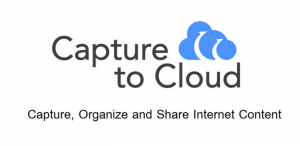 When it comes to capturing snapshots of volatile web content, sharing prototypes of web apps, or even sharing of sites that are saved in a location that your collaborator has no access to, the old solution was to take a screenshot using the SYS REQ key, paste it onto word or Photoshop, and send it to your collaborator.
When it comes to capturing snapshots of volatile web content, sharing prototypes of web apps, or even sharing of sites that are saved in a location that your collaborator has no access to, the old solution was to take a screenshot using the SYS REQ key, paste it onto word or Photoshop, and send it to your collaborator.
This approach only worked so well in the past because there was no alternative, but it overall, it’s a poor means of letting someone experience web content, and a poor choice for assessment work. Nowadays, it is no longer a problem as CaptureToCloud can provide a real solution to the problem of effectively sharing web content.
Provided via the Google Apps Marketplace, CaptureToCloud is a nice little utility that allows users to capture snapshots of web content, with the resulting snapshots that can be kept and used for reference, and shared via the cloud service.
The biggest difference is that the snapshots CaptureToCloud provides are fully functional versions that come with all the relevant scripts, code, and image files. It means it can be readily browsed and access with the experience being similar to what it should be once the content goes live. All ads, links, and effects will be present, with the exception of video, which is unsupported because the large file sizes make it impractical.
As far as flexibility is concerned, CapturetoCloud also comes with the option to store the URL of the content instead of the actual content, making it a bookmark of sorts. There’s also the option of capturing the files along with the URL, so that it works as a cache (content will load faster if the cloud is nearer than the original server’s physical location). It also works as a means of documenting an error on a competitor’s website, and keeping the snapshot even after the site owner manages to fix it.
While it seems like its primary application is for end users who just want to play around with web content or archive their favorite sites, clippings, blogs, or whatnot, CaptureToWeb is also very useful as an enterprise collaboration tool, since employees these days spend a lot of their work time dealing with web-based documents and apps rather than desktop files.
It is also a perfect utility for web devs and designers, particularly ones with employees located in different geographical locations, as they can seamlessly share and collaborate on prototype designs without making the files available on any publicly-accessible or exploitable server.
CaptureToCloud also has support for Chrome and Firefox extensions, providing your browsers with a “capture to cloud” menu bar button or a right mouse click option, which lets you use CaptureToCloud on the fly while browsing sites.
CaptureToCloud also comes with social media functions, such as the ability to add comments and notes, which can be used for collaborative discussions or simply just to document or describe snapshots. There are also features that allow users to easily share their snapshots on Facebook and Twitter. There is no Google+ support though, because like a lot of developers, CaptureToCloud’s devs are still waiting for Google to release a more comprehensive Google+ API. The sharing is secure because it is only provided as a link, so you can always curtail security concerns by disabling the link instead of having to go through the share posts themselves.
Firewalls and password-protected accounts are not a problem for CaptureToCloud, since it uses the browser extension for gathering content and sending to the cloud service. Any website you can access and view from your browser can be saved by CaptureToCloud. Basically, it gets files from your browser instead of directly from the server the site is hosted on.
CaptureToCloud only has the same amount of security risk as copy and pasting image snapshots on Word, in the sense that any access an intruder may have on the private server must come from the person who shared the server, since the tool has no direct access to the secure servers. When accessing public content, though, CaptureToCloud gets files directly from the server in order to facilitate faster transfers.
CaptureToCloud is currently provided on a freemium model, which means the app itself is free but comes with storage and bandwidth limits, which you can extend for a fee. The premium version costs $47.50 annually, with Google Apps administrators being given the ability to enable free or paid accounts for their users from within the administration dashboard.